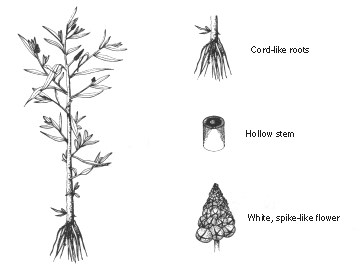Gaertn., Sphenocleaceae

|

|

|

|

|
|
Gaertn., Sphenocleaceae |
|
Present on Pacific Islands? yes
Primarily a threat at high elevations? no
Common name(s): [more details]
|
Chinese: jian ban hua |
|
English: chickenspike, gooseweed, hollowstem, wedgewort |
|
Filipino: mais-mais |
|
Spanish: sfenoclea |
|
Tagalog: silisilihan |
Habit: herb
Description: "Roots numerous, long, cord-like. Stem hollow, up to 150 cm tall, often much branched. Leaf-blade oblong to lanceolate-oblong, attenuate at both ends, acute or obtuse, 2.5-12.5 cm long; petiole up to 3 cm long. Spikes cylindric, up to 7.5 cm long, narrowed at apex; peduncle up to 8 cm long. Bracts and bracteoles spatulate, the tips arched over the flowers except during anthesis. Flowers densely crowded, though characteristically only 1 or 2 open at a time, rhomboid or hexagonal by compression, sessile, wedge-shaped below, attached longitudinally to the rhachis by a linear base. Calyx-segments deltoid-semicircular, obtuse, ultimately slightly accrescent and connivent. Corolla whitish, pinkish or purplish, 2.5-4 mm long; segments ovate-triangular, obtuse or acute, united about half-way, connivent. Filaments slightly dilated at base. Ovary obovoid, 2.5 mm long, apex broad, free, truncate. Capsule 4-5 mm diameter, dehiscing below the calyx-segments which fall with the lid, leaving the scarious base persistent on the rhachis. Seeds yellowish-brown, 0.5 mm long" (Shaw, 1968; pp. 1-2).
 |
Illustration by International Rice Research Institute (IRRI) courtesy Ecoport.
Habitat/ecology: "Thrives in almost any kind of damp ground at altitudes below 350 m. It is found along the sides of ponds, ditches, and rivers, and on dry riverbeds. It grows in seasonal swamps or depressions which are periodically inundated and prefers stagnant water sites. (Holm et al., 1977; p. 446). "In and near pools, swamps, streamsides, periodically inundated depressions, ditches, irrigation channels, and wet places generally, 0-1250 m" (Shaw, 1968; pp. 1-2).
Propagation: Seed
Native range: "Widespread in tropical Africa (excluding the NE Horn) extending south to the Transvaal; also in Madagascar; widespread (but probably introduced) in tropical Asia and America" (Shaw, 1968; pp. 1-2).
Presence:
| Pacific | |||
|
Country/Terr./St. & Island group |
Location |
Cited status &
Cited as invasive & Cited as cultivated & Cited as aboriginal introduction? |
Reference &
Comments |
|
Philippines
Philippine Islands |
Philippine Islands |
introduced
invasive |
Waterhouse, D. F. (1993) (pp. 69, 78) |
|
Philippines
Philippine Islands |
Philippine Islands |
Merrill, Elmer D. (1923) (p. 588)
In open wet places; often a rice-paddy weed. |
|
|
Solomon Islands
Solomon Islands |
Solomon Islands | Swarbrick, John T. (1997) (p. 97) | |
|
Solomon Islands
Solomon Islands |
Solomon Islands |
native
|
Hancock, I. R./Henderson, C. P. (1988) (p. 110) |
| Pacific Rim | |||
|
Country/Terr./St. & Island group |
Location |
Cited status &
Cited as invasive & Cited as cultivated & Cited as aboriginal introduction? |
Reference &
Comments |
|
Cambodia
Cambodia |
Cambodia (Kingdom of) |
introduced
invasive |
Waterhouse, D. F. (1993) (pp. 69, 78) |
|
China
China |
China (People's Republic of) |
introduced
invasive |
Li-ying, Li/Ren, Wang/Waterhouse, D. F. (1997) (pp. 174, 179) |
|
China
China |
Hong Kong |
native
|
Wu, Te-lin (2001) (p. 259)
In wet places. |
|
Indonesia
Indonesia |
Indonesia (Republic of) |
introduced
invasive |
Waterhouse, D. F. (1993) (pp. 69, 78) |
|
Japan
Japan |
Japan |
introduced
|
Mito, Toshikazu/Uesugi, Tetsuro (2004) (p. 189) |
|
Malaysia
Malaysia |
Malaysia (country of) |
introduced
invasive |
Waterhouse, D. F. (1993) (pp. 69, 78) |
|
Negara Brunei Darussalam
Brunei |
Brunei (Negara Brunei Darussalam) |
introduced
invasive |
Waterhouse, D. F. (1993) (pp. 69, 78) |
|
Taiwan
Taiwan Island |
Taiwan Island |
introduced
invasive |
Holm, Leroy G./Plucknett, D. L./Pancho, J. V./Herberger, J. P. (1977) (p. 448) |
|
Thailand
Thailand |
Thailand (Kingdom of) |
introduced
invasive |
Waterhouse, D. F. (1993) (pp. 69, 78) |
|
Vietnam
Vietnam |
Vietnam (Socialist Republic of) |
introduced
invasive |
Waterhouse, D. F. (1993) (pp. 69, 78) |
Control:
Biological: Waterhouse (1994, pp. 230-231) lists the natural enemies of the species.